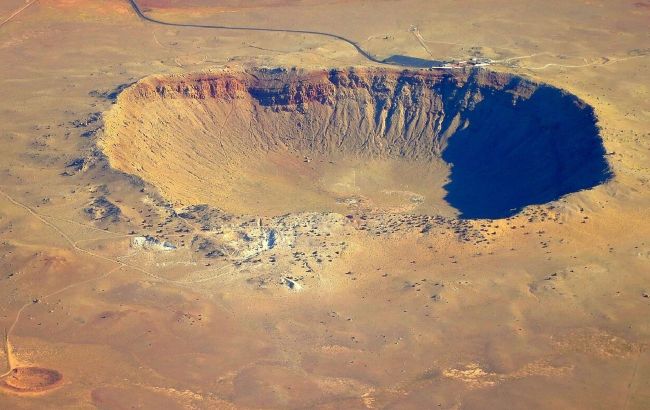Can meteorite destroy Earth? 5 giant celestial bodies that crashed into our planet
 Beringer Crater in Arizona (photo: Wikipedia)
Beringer Crater in Arizona (photo: Wikipedia)
Meteorites are space objects that fall to Earth at high speeds, creating craters and having a significant impact on the environment. For millions of years, meteorite impacts have not only caused destruction, but also contributed to important geological and biological changes.
The Tunguska meteorite
On June 30, 1908, an explosion caused by a meteorite explosion in the atmosphere occurred near the Pidkamyana Tunguska River in Siberia. The force of the explosion is estimated at 40-50 megatons in TNT equivalent, which corresponds to the power of a hydrogen bomb explosion.
The blast wave destroyed the forest over an area of about 2,100 square kilometers. This incident became known as the Tunguska catastrophe. Studies of this phenomenon help scientists better understand the potential risks of large meteorites falling to Earth.
 Trees felled by the explosion (photo: Wikipedia)
Trees felled by the explosion (photo: Wikipedia)
The Sudbury meteorite
Around 1850 million years ago, a huge meteorite hit the Earth's surface, creating a crater known as the Sudbury Basin. Its dimensions are impressive: 64 km long, 25 km wide, and 14 km deep.
In terms of area, this crater is second only to the Vredefort Crater, which is considered the largest on Earth. In 1891, a Canadian copper mining company began mining copper in the area and soon discovered the presence of nickel as well.
The local Sudbury deposit has become one of the most important in the world, as it accounts for a tenth of the world's nickel reserves. This discovery made the Sudbury Basin an important target for the mining industry.
Beringer Crater
The Beringer Crater, located in the Arizona desert, was formed about 50 thousand years ago after a meteorite with a diameter of 48.78 meters fell. This crater is 1.6 km wide and 173 meters deep.
The meteorite that collided with the Earth was traveling at a speed of about 4602 km/h, and the power of the explosion it caused was 150 times greater than the power of the nuclear explosion dropped on Hiroshima. Today, the Beringer Crater is a popular tourist attraction, attracting thousands of visitors every year.
This object has also become important for studying the processes that occur when cosmic bodies collide with the Earth. The crater allows scientists to study the impact of space objects on the planet's surface.
 Crater in Arizona (photo: Wikipedia)
Crater in Arizona (photo: Wikipedia)
Vredefort impact crater
Vredefort Crater, located in South Africa, is considered the largest crater on Earth. It was formed about 2 billion years ago as a result of a meteorite impact, with an estimated diameter of about 9.6 km.
This crater has a diameter of over 250 km, making it the largest impact crater on the planet. Vredefort Crater is about 2 billion years old, and this discovery has become important in understanding the geological evolution of the Earth.
Scientific studies of the crater provide unique information about the processes of planet formation and its geological structure. Vredefort was included in the UNESCO World Heritage List, which confirms its significance for science and culture.
The fall of the Chicxulub meteorite
One of the most famous and discussed events is the fall of a meteorite that caused the extinction of dinosaurs. It is believed that about 66 million years ago, a meteorite with a diameter of 9.6 km collided with the Earth, creating a crater with a diameter of 177 km.
This fall caused global climate change, including acid rain and dust that blocked sunlight for many months. Scientists believe that such an event led to the mass extinction of animals and plants across the planet.
The meteorite also caused a powerful tsunami and fires that further worsened living conditions. This fall was one of the most catastrophic in the history of the Earth.
 An artistic depiction of the meteorite impact and the death of dinosaurs (photo: Wikipedia)
An artistic depiction of the meteorite impact and the death of dinosaurs (photo: Wikipedia)
Earlier we wrote about the 5 most destructive earthquakes in human history.
Read also about the history of the five great cities of forgotten civilizations.
Sources: History, Live Science, Wikipedia.

